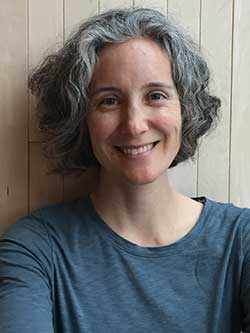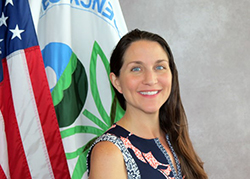NARPM Presents...Stress and Environmental Contamination: Tips and Tools from ATSDR
Sponsored by: EPA Office of Superfund Remediation and Technology Innovation
Environmental contamination can disrupt life as usual. Community members may feel stress for several reasons, including health and financial concerns. Join this webinar to learn more about stress, how it can affect health, and why environmental contamination can cause it. We’ll offer practical tips and tools for acknowledging stress with community members and helping them cope. The webinar will wrap up with suggestions for dealing with stress you may feel as a professional working with communities affected by environmental contamination.
Attendees may be interested in Agency for Toxic Substances and Disease Registry (ATSDR) stress-focused fact sheets and materials. Please see:
- Coping with the stress that environmental contamination can cause - explains why contamination can cause stress and suggests steps people can take to cope (also available in Spanish)
- Blog post – on using the Stress Fact Sheet in Tucson, AZ
- Stress from Relocation – tips for helping families deal with stress from relocation after a disaster
Accessibility, Recording, and Content Disclaimer
Rehabilitation Act Notice for Reasonable Accommodation
It is EPA's policy to make reasonable accommodation to persons with disabilities wishing to participate in the agency's programs and activities, pursuant to the Rehabilitation Act of 1973, 29 U.S.C. 791. Any request for accommodation should be made to at or , preferably one week or more in advance of the webinar, so that EPA will have sufficient time to process the request. EPA would welcome specific recommendations from requestors specifying the nature or type of accommodation needed. Please note that CLU-IN provides both alternate phone call-in options and closed captioning for all webinars, and requests for these specific accommodations are not necessary.
Webinar Recording
By participating in this CLU-IN webinar, you automatically agree to authorize recording of audio and visual content presented during this live event and consent to subsequent use of this recording in the public domain by the U.S. Environmental Protection Agency. This recording may include questions, comments and poll responses provided by you during the live event in addition to your name, voice, image or likeness. This recording will be made available after the conclusion of the live event as part of the CLU-IN webinar archives, and will remain available indefinitely. If you do not wish to consent to the recording, please do not join the live event, and contact Jean Balent at 202-566-0832 or balent.jean@epa.gov to discuss your concerns.
Content Disclaimer
This webinar is intended solely to provide information to the public. The views and opinions expressed as part of this webinar do not necessarily state or reflect those of the U.S. Environmental Protection Agency. It is not intended, nor can it be relied upon, to create any rights enforceable by any party in litigation with the United States, or to endorse the use of products or services provided by specific vendors. With respect to this webinar, neither the United States Government nor any of their employees, makes any warranty, express or implied, including the warranties of merchantability and fitness for a particular purpose, or assumes any legal liability or responsibility for the accuracy, completeness, or usefulness of any information, apparatus, product, or process disclosed, or represents that its use would not infringe privately owned rights.
Presenters:
 Pam Tucker, MD, Medical Officer, ATSDR (pgt0@cdc.gov or 770-488-3458)
Pam Tucker, MD, Medical Officer, ATSDR (pgt0@cdc.gov or 770-488-3458)
 Ben Gerhardstein, MPH, Environmental Health Scientist, ATSDR Region 9 (bgerhardstein@cdc.gov or 415-947-4316)
Ben Gerhardstein, MPH, Environmental Health Scientist, ATSDR Region 9 (bgerhardstein@cdc.gov or 415-947-4316)
 Jamie Rayman, M.P.H., Agency for Toxic Substances and Disease Registry (fpe7@cdc.gov or 415-947-4318)
Jamie Rayman, M.P.H., Agency for Toxic Substances and Disease Registry (fpe7@cdc.gov or 415-947-4318)
Jamie Rayman, M.P.H., is a health educator and community involvement specialist in the Agency for Toxic Substances and Disease Registry's Region 9 office in San Francisco, CA. Jamie has experience interacting with communities concerned about air-, soil-, and waterborne exposures to heavy metals and radiation. She uses plain language to develop communications and public education materials that convey environmental health messages to communities affected by contamination. As the Community Engagement Lead for the ATSDR PFAS Multi-site Study Rayman supports community engagement conducted by CDC/ATSDR grantees. She has a Master's of Public Health in behavioral and community health science from the University of Pittsburgh.
Moderator:
 Jean Balent, U.S. EPA Office of Superfund and Emergency Management (OSEM) (balent.jean@epa.gov or 202-566-0832)
Jean Balent, U.S. EPA Office of Superfund and Emergency Management (OSEM) (balent.jean@epa.gov or 202-566-0832)
Ms Balent is on the staff of the EPA's Technology Innovation and Field Services Division where she has worked to collect and disseminate hazardous waste remediation and characterization information since 2003. Ms Balent manages the Clean Up Information Network website and actively supports online communication and collaboration resources available to EPA. She formerly worked with the US Army Corps of Engineers Environmental Engineering Division in the Buffalo District. Ms Balent was also a member of the SUNY-Buffalo Groundwater Research Group where she constructed and tested large scale models of groundwater flow. Ms Balent has also conducted research relating to the Great Lakes, environmental remediation, and brownfields re-development. She holds a Bachelor's degree in environmental engineering from SUNY-Buffalo and a Master's degree in Information Technology from AIU.
Webinar Slides and References:
Webinar Slides and References:
Additional Resources:
 Coping with the Stress that Environmental Contamination can Cause fact sheet
Coping with the Stress that Environmental Contamination can Cause fact sheet
 Tips for using the "Coping with Stress" fact sheet
Tips for using the "Coping with Stress" fact sheet Additional Reading About Stress
Additional Reading About Stress- Stressful Environments: Coping with Contamination in Your Community CDC/ATSDR Your Health, Your Environment Blog Post
 Helping Families Deal with the Stress of Relocation After a Disaster fact sheet
Helping Families Deal with the Stress of Relocation After a Disaster fact sheet
Thank you for participating in our webinar. We would like to receive any feedback you might have that would make this service more valuable.
Help & FAQs
Adobe Connect Resources
This seminar will be delivered through Adobe® Connect™ with streaming audio delivered through your computer speakers or headphones. We strongly encourage you to test your computer or mobile app prior to attending this seminar using the links below. Technical support on the day of the seminar will be very limited and subject to significant delays.
- Adobe® Connect™ Meeting Connection Diagnostic & Troubleshooting Tips
- Adobe® Connect™ Mobile Apps
- Adobe® Connect™ Visual Quick Start Guide (754KB/2pp/PDF)
Rehabilitation Act Notice for Reasonable Accommodation
It is EPA's policy to make reasonable accommodation to persons with disabilities wishing to participate in the agency's programs and activities, pursuant to the Rehabilitation Act of 1973, 29 U.S.C. 791. Any request for accommodation should be made to at or , preferably one week or more in advance of the seminar, so that EPA will have sufficient time to process the request. EPA would welcome specific recommendations from requestors specifying the nature or type of accommodation needed, such as closed captioning.
with any additional questions




